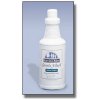The Toxic Dangers of Typical Laundry Detergent
by www.SixWise.com
We all take great pains to make sure our clothes are clean
and fresh, but, ironically, the very detergents that we use
to make our clothes "clean" may actually be leaving
them worse off than they were before we threw them in the
wash. That's because most commercial laundry detergents, the
common brands you find at grocery stores, are loaded with
potentially toxic chemicals that could harm you, your family
and the environment.
|

Ordinary laundry detergents could leave dangerous chemical
residues on clothes and skin.
|
Residues of these chemicals are left on your clothes and
possibly absorbed by your skin and evaporated into the air
where they could be breathed in.
A Typical Laundry Detergent
If you take a look at a bottle of laundry detergent, you'll
find that the ingredients are rather vague. One popular brand
listed, for instance:
- Cleaning agents (anionic and nonionic surfactants)
- Buffering agent
- Stabilizer
- Brightening agent
- Fragrance
From this list, it's hard to tell what, exactly, is even
in the detergent, so we broke down some of the more common
laundry ingredients out there.
Linear alkyl sodium sulfonates (LAS): These synthetic
surfactants are commonly listed as 'anionic surfactants' on
labels, and are one of the most common surfactants in use.
During their production process, carcinogenic and reproductive
toxins such as benzene are released into the environment.
They also biodegrade slowly, making them a hazard in the environment.
Petroleum distillates (aka napthas): These chemicals
have been linked to cancer, lung damage, lung inflammation
and damage to mucous membranes.
Phenols: According to the National Institutes of Health,
phenol is toxic and people who are hypersensitive to it could
experience death or serious side effects at very low exposures.
Plus, it is rapidly absorbed and can cause toxicity throughout
the entire body. Typically, death and severe toxicity result
from phenol's effects on the central nervous system, heart,
blood vessels, lungs and kidneys.
One common surfactant in U.S. laundry detergents is nonyl
phenol ethoxylate (this chemical has been banned in Europe,
and was found to slowly biodegrade into even more toxic compounds).
Studies have found that this surfactant stimulates the growth
of breast cancer cells and feminizes male fish.
|

Are chemicals in commercial laundry detergents leaving
your clothes dangerously clean?
|
Optical brighteners: These synthetic chemicals convert
UV light wavelengths into visible light, which makes laundered
clothes appear whiter (although does not actually affect the
cleanliness of the clothing). They've been found to be toxic
to fish and to cause bacterial mutations. Further, they can
cause allergic reactions when exposed to skin that is later
exposed to sunlight.
Phosphates: These chemicals are used to remove hard-water
minerals to make detergents more effective, and to prevent
dirt from settling back onto clothes during a wash. A major
problem with them is that, when released into the environment,
they stimulate the growth of certain marine plants, which
contributes to unbalanced ecosystems. Many states have banned
or restricted the use of phosphates for this reason, and you
may see laundry detergents advertised as "low-phosphate"
or "phosphate-free."
Sodium hypochlorite (household bleach): This is a
chemical precursor to chlorine, which is highly toxic and
involved in more household poisonings than any other chemical.
When it reacts with organic materials in the environment,
carcinogenic and toxic compounds are created than can cause
reproductive, endocrine and immune system disorders.
EDTA (ethylene-diamino-tetra-acetate): EDTA is a class
of compounds used as an alternative to phosphates to reduce
mineral hardness in water, prevent bleaching agents from becoming
active before they're put in water and as a foaming stabilizer.
EDTA does not biodegrade readily and can re-dissolve toxic
heavy metals in the environment, allowing them to re-enter
the food chain.
|
Enviro-Rite Gentle Wash: Clean Clothes With No Chemicals
Added!
 Gentle
Wash is a highly effective, ultra-concentrated, ready-to-use
detergent solution that leaves behind no residue to
irritate sensitive skin. No harsh chemicals. No soapy
residue. No fragrances--Just CLEAN Results! Gentle
Wash is a highly effective, ultra-concentrated, ready-to-use
detergent solution that leaves behind no residue to
irritate sensitive skin. No harsh chemicals. No soapy
residue. No fragrances--Just CLEAN Results!
Reasons to Choose Gentle Wash for Delicate Fabrics:
-
Developed by and for people with allergies, asthma,
and chemical sensitivities.
-
Free of phosphates, petroleum solvents, chlorine,
perfumes, dyes, animal byproducts, and other common
triggers for respiratory or skin irritations.
-
Non-caustic/pH neutral at ready-to-use dilutions.
Effectively dissolves and removes acid and alkaline-based
soils.
-
Safe for all washable fabrics.
-
No animals were used in the testing of this product.
-
An environmentally responsible product.
Learn
More and Order
Enviro-Rite Gentle Wash Now!
|
Artificial fragrances: Many of these can be made from
petroleum (see petroleum distillates above), and do not degrade
in the environment. They've been linked to various toxic effects
on fish and mammals, and often cause allergies and skin and
eye irritation.
Safe Laundry Alternatives
If you want to be sure that your laundry is as non-toxic
and safe as possible, seek out a natural brand of laundry
detergent. If you're looking for a reputable brand, we highly
recommend the Enviro-Rite
line of laundry detergents.
If you have allergies, asthma or chemical sensitivities,
we STRONGLY URGE YOU TO CONSIDER Enviro-Rite
Gentle Wash, a highly effective, ultra-concentrated, ready-to-use
detergent solution that leaves behind no residue to irritate
sensitive skin, plus is free of phosphates, petroleum solvents,
chlorine, perfumes, dyes, animal byproducts, and other toxic
compounds.
Recommended Reading
The Toxic
Danger of Fabric Softener and Dryer Sheets
Sources
Poisons
Under Your Sink
Solutions
for a Healthy Home
Seventh
Generation Chemical Glossary
Chemicals
and Your Home
The
Dangers of Toxins